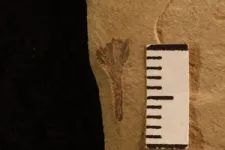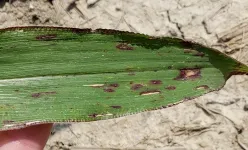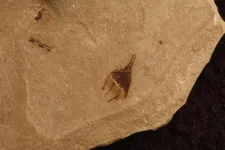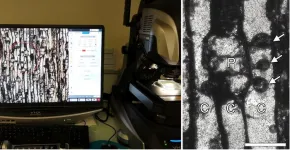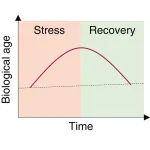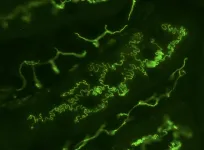(Press-News.org) CHAMPAIGN, Ill. — An exploded star can pose more risks to nearby planets than previously thought, according to a new study from NASA’s Chandra X-ray Observatory and other X-ray telescopes. This newly identified threat involves a phase of intense X-rays that can damage the atmospheres of planets up to 160 light-years away.
The results of the study, led by researchers at the University of Illinois Urbana-Champaign, Washburn University and the University of Kansas, are published in the Astrophysical Journal.
Earth is not in danger of such a threat today because there are no potential supernova progenitors within this distance, but it may have experienced this kind of X-ray exposure in the past, scientists say.
Before this study, most research on the effects of supernova explosions focused on the danger from two periods: the intense radiation produced by a supernova in the days and months after the explosion, and the energetic particles that arrive hundreds to thousands of years afterward.
However, even these alarming threats do not fully catalog the dangers in the wake of an exploded star. Researchers have discovered that between these two previously identified dangers lurks another. The aftermaths of supernovae always produce X-rays, but if the supernova’s blast wave strikes dense surrounding gas, it can produce a particularly large dose of X-rays that arrives months to years after the explosion and may last for decades.
The calculations in this latest study are based on X-ray observations of 31 supernovae and their aftermath mostly obtained from Chandra, NASA’s Swift and NuSTAR missions and the European Space Agency’s XMM-Newton mission. The analysis of these observations shows that supernovae interacting with their surroundings can have lethal consequences for planets located up to about 160 light-years away.
“If a torrent of X-rays sweeps over a nearby planet, the radiation would severely alter the planet’s atmospheric chemistry,” said Ian Brunton, a former Illinois undergraduate now at NASA Johnson Space Flight Center and the first author of the study. “For an Earth-like planet, this process could wipe out a significant portion of ozone, which ultimately protects life from the dangerous ultraviolet radiation of its host star.”
If a planet with Earth’s biology were hit with sustained high-energy radiation from a nearby supernova, especially one strongly interacting with its surroundings, it could lead to the demise of a wide range of organisms, especially in marine environments at the foundation of the food chain. These effects may be significant enough to initiate a mass extinction event.
“The Earth is not in any danger from an event like this now because there are no potential supernovae within the X-ray danger zone,” said Illinois undergraduate student Connor O’Mahoney, a co-author of the study. “However, it may be the case that such events played a role in Earth’s past.”
There is strong evidence – including the detection in different locations around the globe of a radioactive type of iron – that supernovae occurred close to Earth between about two and eight million years ago. Researchers estimate these supernovae were between about 65 and 500 light-years away from Earth.
Earth is in the “Local Bubble,” a still-expanding bubble of low-density hot gas surrounded by a shell of cold gas that spans about 1,000 light-years. The outward expansion of stars near the surface of the Local Bubble implies that it formed from a burst of star formation and supernovae near the center of the bubble about 14 million years ago, the researchers said.
The massive young stars responsible for the supernova explosions were then much closer to our planet than such stars are now, which put Earth at much higher risk from these supernovae in the past.
While this evidence does not tie supernovae to any particular mass extinction event on Earth, it does suggest cosmic explosions have affected our planet over its history, the researchers said.
The study reports that although the Earth and the solar system are currently in a safe space in terms of potential supernova explosions, many other planets in the Milky Way are not. These high-energy events would effectively shrink the areas within the Milky Way galaxy, known as the Galactic Habitable Zone, where conditions would be conducive for life.
Because the X-ray observations of supernovae are sparse, particularly of the variety that strongly interact with their surroundings, the researchers said that follow-up observations of interacting supernovae for months and years after the explosion would be valuable.
“Further research on X-rays from supernovae is valuable not just for understanding the life cycle of stars,” said astronomy professor Brian Fields, who directed the Illinois portion of the study, “but also has implications for fields like astrobiology, paleontology and the earth and planetary sciences.”
Fields also is affiliated with physics and the Illinois Center for Advanced Studies of the Universe at the U. of I.
NASA’s Marshall Space Flight Center manages the Chandra program. The Smithsonian Astrophysical Observatory’s Chandra X-ray Center controls science operations from Cambridge, Massachusetts, and flight operations from Burlington, Massachusetts.
Editor’s notes:
This is a modified version of a news release distributed by NASA.
To reach Brian Fields, call 217-333-5529; email bdfields@illinois.edu.
The paper “X-Ray-luminous supernovae: threats to terrestrial biospheres” is available online.
DOI: 10.3847/1538-4357/acc728
END
New stellar danger to planets identified by NASA'S Chandra program
2023-04-21
ELSE PRESS RELEASES FROM THIS DATE:
Why are COVID-19 vaccination rates among children so low? Parents’ worry about long-term risks, responsibility
2023-04-21
Despite efforts by the U.S. Centers for Disease Control and Prevention and pediatric clinicians to increase the COVID-19 vaccination rate among children, many remain unvaccinated due to parental concerns about the vaccine’s long-term effects and anticipated responsibility. Those are findings from a new study published in Pediatricsand conducted by the Center for Economic and Social Research(CESR) at the USC Dornsife College of Letters, Arts and Sciences.
The researchers sought to determine the causes of low child vaccination rates. Currently, only 39% of children 5 to 11 and 68% of those 12 to 17 have received ...
Insignum AgTech and Beck’s collaborate to help corn ‘talk’
2023-04-21
ATLANTA, Ind. – Insignum AgTech® and Beck’s have signed an agreement to test Insignum’s innovative corn traits in Beck’s elite varieties. The companies will collaborate to cross the trait into proprietary Beck’s genetics for field-testing in 2023 to evaluate commercial viability of the traits.
Insignum AgTech develops plant genetic traits that enable plants to “talk” and signal to farmers when specific plant stresses begin.
“With this trait, a corn plant generates purple pigment, indicating that a fungal infection has started ...
New study uncovers Colorado’s spicy ancient history of chili peppers
2023-04-21
Botanists and paleontologists, led by researchers from the University of Colorado Boulder, have identified a fossil chili pepper that may rewrite the geography and evolutionary timeline of the tomato plant family.
The team’s findings, published last month in the journal New Phytologist, show that the chili pepper tribe (Capsiceae) within the tomato, or nightshade (Solanaceae), family is much older and was much more widespread than previously thought. Scientists previously believed that chili peppers evolved in South America at most ...
360-million-year-old Irish fossil provides oldest evidence of plant self-defense in wood
2023-04-21
An international team of scientists, co-led by Dr Carla J. Harper, Assistant Professor in Botany in the School of Natural Sciences at Trinity, has discovered the oldest evidence of plant self-defence in wood in a 360-million-year-old fossil from south-eastern Ireland.
Plants can protect their wood from infection and water loss by forming special structures called “tyloses”. These prevent bacterial and fungal pathogens from getting into the heartwood of living trees and damaging it. However, it was not previously known how early in the evolution of plants woody species became capable of forming such defences.
Published ...
New paper advances understanding of geographic health disparities
2023-04-21
By looking at where people were born instead of where they ultimately move to and die, geographic disparities in mortality look different than previously assumed, according to a new study published on April 1, 2023, in the journal Demography.
interstate migration may mitigate regional inequalities in mortality according to “Understanding Geographic Disparities in Mortality,” a paper led by Jason Fletcher, professor in the La Follette School of Public Affairs at the University of Wisconsin–Madison and director of the Center for Demography of Health and Aging with an appointment in Population Health Sciences.
“At a time when nearly ...
Newly funded Morris Animal Foundation study assesses CBD use for postsurgical pain in dogs
2023-04-21
DENVER/April 21, 2023 – A new study is testing whether the addition of CBD can improve pain management in dogs following orthopedic surgery. The study, funded by Morris Animal Foundation, will be conducted by a veterinary research team at the University of Saskatchewan, Canada.
CBD use in pets has gained in popularity in the last decade, but there are few controlled studies closely examining its efficacy as a pain management tool. This study hopes to help partially close this knowledge gap.
The research team, led by Dr. Alan Chicoine, Assistant Professor, Department ...
Endocrine Society endorses bipartisan bill to address insulin affordability
2023-04-21
WASHINGTON—The Endocrine Society today endorsed the Improving Needed Safeguards for Users of Lifesaving Insulin Now (INSULIN) Act of 2023, a bipartisan insulin affordability bill introduced by Sens. Jeanne Shaheen (D-NH) and Susan Collins (R-ME). This legislation would cap out-of-pocket insulin costs for those with private insurance, ensure patients can share in insulin rebates and discounts, and promote competition in the insulin market.
These measures would protect access to life-saving insulin for more than 7 million people nationwide who rely on the medication to manage their diabetes. According to the U.S. Center for Disease Control ...
Biological age is increased by stress and restored upon recovery
2023-04-21
The biological age of humans and mice undergoes a rapid increase in response to diverse forms of stress, which is reversed following recovery from stress, according to a study publishing on April 21 in the journal Cell Metabolism. These changes occur over relatively short time periods of days or months, according to multiple independent epigenetic aging clocks.
“This finding of fluid, fluctuating, malleable age challenges the longstanding conception of a unidirectional upward trajectory of biological age over the life course,” says co-senior study author James White of Duke University School of Medicine. “Previous reports ...
Most people feel “psychologically close” to climate change
2023-04-21
When spurring action against climate change, NGOs and governmental agencies frequently operate on the assumption that people are unmotivated to act because they view climate change as a problem that affects distant regions far in the future. While this concept, known as psychological distance, seems intuitive, researchers report in the journal One Earth on April 21 that most people see climate change as an important and timely issue even if its impacts are not immediately noticeable.
“There is no consistent evidence ...
The Mathematics of Cell Boundary 'Ruggedness'
2023-04-21
Fukuoka, Japan—Researchers have uncovered both the mathematical and biological mechanism behind the rugged structures at cell boundaries found in tissues such as the kidneys and nasal glands. The team hopes that their new insights can help develop new ways of treating associated pathologies and build better biological models for future study.
Our cells come in all sorts of shapes and sizes. From the neurons that extend across the central nervous system, to the spherical white blood cells that protect us from infection, a cell's form and ...


